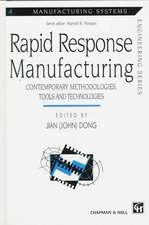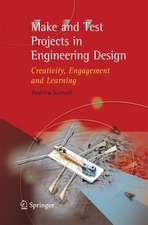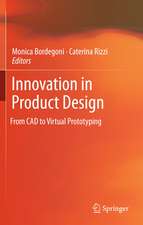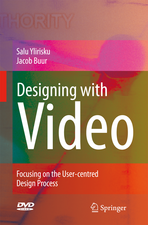The Design Guidelines Collaborative Framework: A Design for Multi-X Method for Product Development
Autor Stefano Filippi, Ilaria Cristofolinien Limba Engleză Paperback – 29 noi 2014
| Toate formatele și edițiile | Preț | Express |
|---|---|---|
| Paperback (1) | 635.80 lei 6-8 săpt. | |
| SPRINGER LONDON – 29 noi 2014 | 635.80 lei 6-8 săpt. | |
| Hardback (1) | 642.03 lei 6-8 săpt. | |
| SPRINGER LONDON – 15 dec 2009 | 642.03 lei 6-8 săpt. |
Preț: 635.80 lei
Preț vechi: 748.00 lei
-15% Nou
Puncte Express: 954
Preț estimativ în valută:
121.66€ • 127.02$ • 100.69£
121.66€ • 127.02$ • 100.69£
Carte tipărită la comandă
Livrare economică 04-18 aprilie
Preluare comenzi: 021 569.72.76
Specificații
ISBN-13: 9781447157649
ISBN-10: 1447157648
Pagini: 204
Ilustrații: XIV, 186 p.
Dimensiuni: 155 x 235 x 11 mm
Greutate: 0.29 kg
Ediția:2010
Editura: SPRINGER LONDON
Colecția Springer
Locul publicării:London, United Kingdom
ISBN-10: 1447157648
Pagini: 204
Ilustrații: XIV, 186 p.
Dimensiuni: 155 x 235 x 11 mm
Greutate: 0.29 kg
Ediția:2010
Editura: SPRINGER LONDON
Colecția Springer
Locul publicării:London, United Kingdom
Public țintă
ResearchCuprins
State of the Art in the Field.- The DGLs-CF — Introduction and Background.- Detailed Description of the DGLs-CF.- Adopting the DGLs-CF in the Field.- Discussion and Hints for Future Work.
Notă biografică
Stefano Filippi is an associate professor of Design and Methods in Industrial Engineering at the Electrical, Management and Mechanical Engineering Department of the University of Udine, Italy. He received his PhD from the Polytechnic of Milan, Italy. His research is mainly focused on Knowledge-based Engineering; Knowledge-based Innovation Systems (he has co-founded APEIRON, a non-profit association focused on studying and disseminating the TRIZ theory in Italy); Rapid Prototyping in Medicine and in Cultural Heritage; and Usability. He has been developing the Design GuideLines framework since 2002, always in strong connection with industrial environments and trying to solve real problems. The usability aspects of methods and tools have always had a key role in his research topics. His research has been published in the International Journal of Production Research; Research in Engineering Design; the Journal of Oral and Maxillofacial Surgery; and the IEEE Robotics&Automation Magazine.
Ilaria Cristofolini is an assistant professor in the field of Design Theory and Methodology at the Mechanical and Structural Engineering Department at the University of Trento, Italy. She received her PhD from the University of Padua, Italy. Her research areas concern Knowledge-based Design Systems; Geometric Dimensioning and Tolerancing; Standards Evolution; and Application and Verification of Geometric Tolerances. She also worked as Head of the Quality Assurance System in a firm producing sheet metal components. She participates in projects like Laser Interferometry Space Antenna, a joint mission of NASA and ESA for Fundamental Physics Studies, and Study for the Production of Exotic Species. Through her work she managed problems concerning the influence of manufacturing and verification technologies on the final quality of products, and she experienced the need for consideration of these technologies to start with the design process. Herresearch has been published in Research in Engineering Design; Classical and Quantum Gravity; Powder Metallurgy; the International Journal of Powder Metallurgy; and Measurement and Control.
Ilaria Cristofolini is an assistant professor in the field of Design Theory and Methodology at the Mechanical and Structural Engineering Department at the University of Trento, Italy. She received her PhD from the University of Padua, Italy. Her research areas concern Knowledge-based Design Systems; Geometric Dimensioning and Tolerancing; Standards Evolution; and Application and Verification of Geometric Tolerances. She also worked as Head of the Quality Assurance System in a firm producing sheet metal components. She participates in projects like Laser Interferometry Space Antenna, a joint mission of NASA and ESA for Fundamental Physics Studies, and Study for the Production of Exotic Species. Through her work she managed problems concerning the influence of manufacturing and verification technologies on the final quality of products, and she experienced the need for consideration of these technologies to start with the design process. Herresearch has been published in Research in Engineering Design; Classical and Quantum Gravity; Powder Metallurgy; the International Journal of Powder Metallurgy; and Measurement and Control.
Textul de pe ultima copertă
The Design Guidelines Collaborative Framework describes a knowledge-based ‘design for multi-X’ method, aimed at improving and assisting the work of designers, manufacturers, and inspectors in the areas of product redesign and process reconfiguration.
Designers are not necessarily experts in manufacturing and verification processes; likewise, manufacturers and inspectors may not be experts in design. For this reason, the Design Guidelines Collaborative Framework (DGLs-CF) constitutes a meeting point for all three parties, where their knowledge is formalized, expanded upon, and put at the designers’ disposal, thereby maximizing the user-friendliness of the results.
The DGLs-CF is characterized by the homogeneous union of different algorithms, clear interfaces among the modules that implement them, and clear roles assigned to the different actors. These elements, together with a strong adherence to the ISO GPS standards, make the DGLs-CF the perfect environment for researchers, experts in different fields, and industrial partners to formalize their knowledge, and develop and implement their own algorithms and procedures.
The Design Guidelines Collaborative Framework uses the simple IDEF0 formalism to describe the DGLs-CF framework in a top-down way, in order to facilitate readers’ comprehension, and their adoption and development of the framework. Several case studies on the application of the DGLs-CF in industrial environments show the framework’s effectiveness and robustness.
Industrial and academic researchers will find this book a useful guide to the DGLs-CF and mechanical engineers will be quick to appreciate the streamlined approach it describes.
Designers are not necessarily experts in manufacturing and verification processes; likewise, manufacturers and inspectors may not be experts in design. For this reason, the Design Guidelines Collaborative Framework (DGLs-CF) constitutes a meeting point for all three parties, where their knowledge is formalized, expanded upon, and put at the designers’ disposal, thereby maximizing the user-friendliness of the results.
The DGLs-CF is characterized by the homogeneous union of different algorithms, clear interfaces among the modules that implement them, and clear roles assigned to the different actors. These elements, together with a strong adherence to the ISO GPS standards, make the DGLs-CF the perfect environment for researchers, experts in different fields, and industrial partners to formalize their knowledge, and develop and implement their own algorithms and procedures.
The Design Guidelines Collaborative Framework uses the simple IDEF0 formalism to describe the DGLs-CF framework in a top-down way, in order to facilitate readers’ comprehension, and their adoption and development of the framework. Several case studies on the application of the DGLs-CF in industrial environments show the framework’s effectiveness and robustness.
Industrial and academic researchers will find this book a useful guide to the DGLs-CF and mechanical engineers will be quick to appreciate the streamlined approach it describes.
Caracteristici
Describes the Design Guidelines framework A knowledge-based collection of methods and tools aimed at effectively helping and leading the activities of designers, manufacturers and inspectors for product design and optimization Includes supplementary material: sn.pub/extras




























